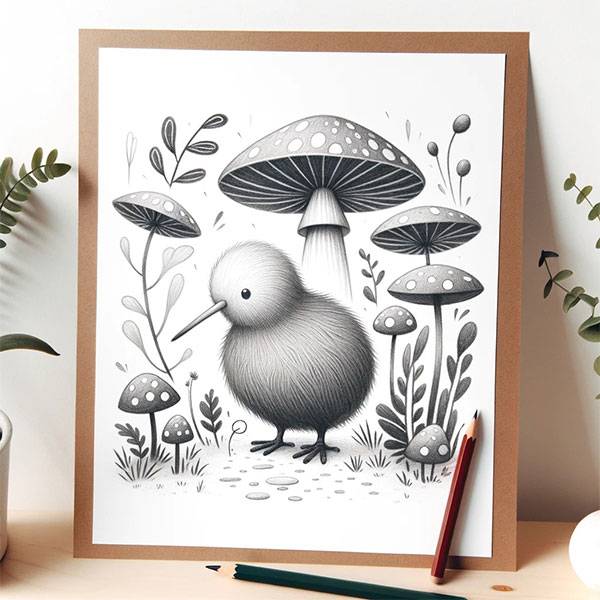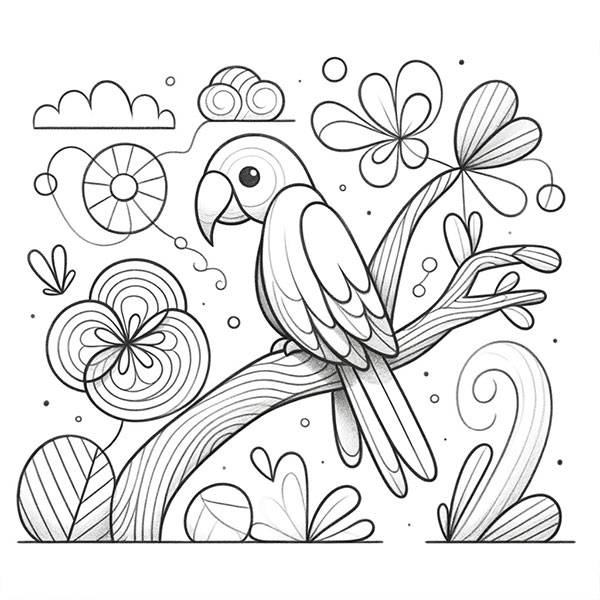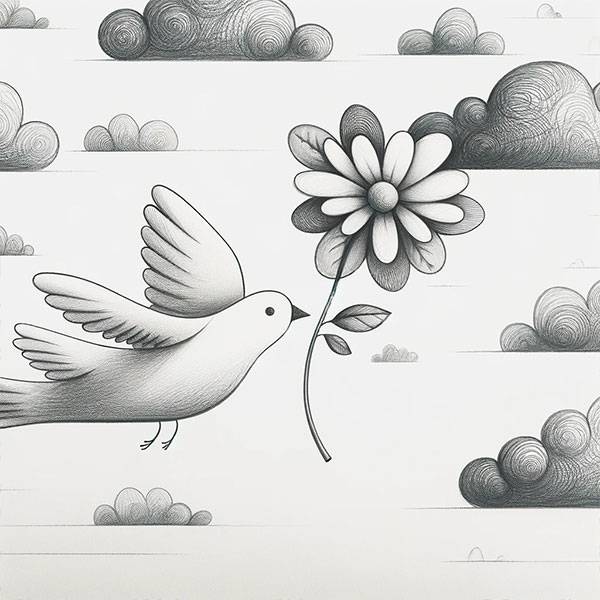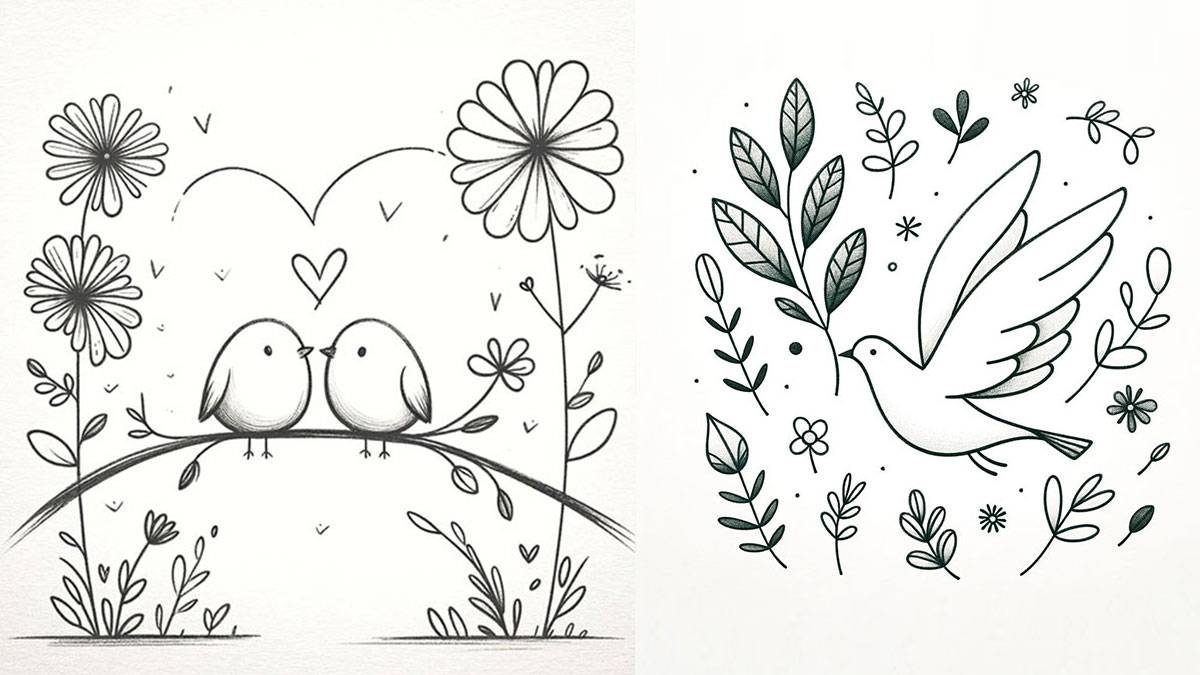Taking Flight with Pencil Drawing
Pencil drawing offers an accessible and enjoyable way to capture the world around you, one line at a time. And what could be more delightful than sketching our feathered friends? Whether perched in your garden or soaring through the pages of your sketchbook, birds provide endless inspiration for your artistic adventures.

Why Birds Make the Perfect Sketching Companions
Birds, with their intricate feathers and dynamic postures, are nature’s perfect models for any budding artist. They come in all shapes, sizes, and colors, offering a variety of subjects that won’t squawk if you stare at them too long. Plus, they’re free! No need to hire a professional model when you have a park full of pigeons or a backyard birdbath frequented by finches.
Birds also come with their own set of challenges that will keep your drawing skills sharp. Capturing the essence of a bird’s flight or the delicate texture of its feathers can be as rewarding as finally nailing that perfect soufflé recipe. Each bird you draw is like a mini-feathered puzzle waiting to be solved with your trusty pencil.
The Simple Joy of Pencil Drawing
Pencil drawing is the art equivalent of comfort food—it’s reliable, no-fuss, and always satisfying. With just a pencil and paper, you can create stunning visuals that rival the latest 4K screens, all while enjoying the tactile pleasure of graphite on paper.
Whether you’re sketching a quick doodle or composing a detailed realistic pencil drawing, the humble pencil is your ticket to an artful escape. It’s time to let your creative spirit soar like an eagle—or perhaps more like a quirky parrot with a penchant for mischief. Either way, you’ll be on your way to creating something truly tweet-worthy!
Don’t forget, if you’re new to this whole drawing birds—or anything, really—business, you’ll find solace and instruction in our pencil drawing for beginners. And once you’ve conquered the avian realm, why not try your hand at a landscape pencil drawing or a dramatic pencil drawing of mountains? The sky’s the limit, and your pencil is the wand that brings magic to the page.

Gathering Your Nest of Supplies
Before you embark on the whimsical adventure of creating your very own pencil drawing of birds, you’ll want to gather a nest of supplies that’ll make your drawing experience a hoot!
Essential Tools for Pencil Drawing
You don’t need a peacock’s plumage of tools to get started, just a few basics:
- Pencils: A range of graphite pencils from hard (H) to soft (B) will give you the versatility to create intricate details and bold shadows. A typical range might include 2H for light sketching and 6B for those darker tones, like the mysterious shadows under an eagle’s wings.
- Erasers: A trusty rubber eraser for larger mistakes and a precision kneaded eraser for gently lifting graphite without ruffling any feathers.
- Paper: Opt for a heavyweight, textured paper that can handle erasing and layering without buckling or tearing, like a tough bird that can weather any storm.
- Sharpener: A good sharpener is worth its weight in birdseed, giving you a fine point for detailed work, like the intricate patterns on a sparrow’s breast.
- Blending tools: Tortillons or blending stumps are fantastic for smoothing out gradients, much like smoothing out ruffled feathers.
Here’s a little table to help you keep track of your tools:
| Tool | Use |
|---|---|
| Graphite Pencils (2H-6B) | Sketching and shading |
| Rubber Eraser | Correcting larger mistakes |
| Kneaded Eraser | Fine-tuning and lightening areas |
| Textured Paper | Durable surface for drawing |
| Sharpener | Maintaining a sharp pencil point |
| Blending Stumps | Softening and blending graphite |
Preparing Your Workspace
Setting up your workspace is like building a nest; it should be comfy and functional.
- Lighting: Ensure you have plenty of light to see the fine details of your feathered friends. Natural light is best, but a good lamp can also do the trick.
- Organization: Keep your tools within arm’s reach. A tidy workspace is like a well-preened bird – it just feels better.
- Comfort: A comfortable chair and desk at the right height will keep your back from squawking in protest after long drawing sessions.
- Inspiration: Surround yourself with images of birds or maybe even set up a bird feeder outside your window for live models. Just don’t let the squirrels hog all the views!
Once your nest is set, you’re ready to start your journey into the world of pencil drawing of birds. And who knows, with a little practice, you might just become the next ruler of the “sketchy” skies! For more tips and techniques to feather your nest with skills, check out our pencil drawing tutorials.
Basic Techniques for Pencil Drawing

Get ready to unleash the inner artist in you because we’re about to dive into the nitty-gritty of creating a stunning pencil drawing of birds! If you’ve ever wanted to sketch a feathered friend that looks like it might flap off the page, you’re in the right place.
Understanding Pencil Grades
First thing’s first, let’s talk about your graphite companions – pencils. They may seem like a humble bunch, but they hold the power to create soft fluffiness and sharp edges, all with a flick of your wrist. Pencils come in various grades, and each has its place in your avian artwork.
Here’s a quick guide to pencil grades:
| Grade | Hardness | Darkness | Bird Drawing Use |
|---|---|---|---|
| 9H – 2H | Hard | Light | Fine feather details |
| HB | Medium | Medium | General sketching |
| 2B – 9B | Soft | Dark | Shadowing and textures |
For the lightest, barely-there lines, reach for the H’s; these hard-hearted fellows will help you map out your bird without leaving much of a trace. As for the B’s, these softer souls are perfect for when you want to get into the darker side of things, like those dramatic shadows under the wings. And, of course, the trusty HB stands in the middle, ready to tackle just about anything you throw at it.
Mastering Strokes and Shades
Now, let’s talk action. The way you move your pencil across the paper can make or break your birdie masterpiece. You’ve got your basic strokes: lines, hatching, cross-hatching, and the fancier ones like stippling and scumbling. Each one adds texture and depth to your drawing, from sleek wing surfaces to fluffy little bellies.
- Lines: These are the building blocks of your drawing. Keep them light and loose to start.
- Hatching: Think of it as laying down a series of lines side by side. It’s great for adding shades to those curved feathers.
- Cross-Hatching: Now we’re getting fancy. Cross your lines over each other for a deeper texture.
- Stippling: Dots, dots, and more dots. It’s time-consuming but perfect for that speckled breast on a thrush.
- Scumbling: It’s like scribbling with a purpose. Loosen up and let your pencil dance around to create that soft, downy look.
Remember, the pressure you apply changes the game. Press lightly for a gentle touch or go bold and press harder for those dramatic, eye-catching lines. But be warned, heavy-handedness can leave you with a bird that looks like it’s been through a storm, so tread lightly.
By mastering these techniques, you’ll soon have a flock of feathered friends that look as though they could take flight any moment. For more detailed guidance, flutter on over to our pencil drawing tutorials and get ready to spread your artistic wings!
Sketching Bird Basics

As you embark on the whimsical journey of creating a pencil drawing of birds, let’s not wing it—instead, let’s start with the basics. With a dash of humor and a spritz of creativity, you’ll transform simple scribbles into something that almost flutters off the page!
Breaking Down the Bird into Simple Shapes

Before you start sketching, remember that every bird, no matter how complex, can be broken down into basic geometric shapes. Think of it as a puzzle where each piece is a different shape that, when put together, creates a bird that’s ready to soar off your canvas (or at least impress your cat).
- Oval for the Body: Pretty much every bird starts with an oval – think of it as the bird’s own personal egg that it never really left.
- Circle for the Head: A smaller circle gives your bird a noggin. Where you place this circle will determine the bird’s posture and attitude.
- Triangles for the Beak and Tail: Birds are basically geometry fans; they love a good triangle. Use a small one for the beak and a larger, elongated one for the tail.
- Lines for Legs and Feet: Sticks and lines work wonders for legs and feet. Remember, birds often stand on one leg, so don’t feel obligated to draw both unless you’re feeling particularly symmetrical.
Here’s a handy table to remind you of the shapes:
| Body Part | Shape |
|---|---|
| Body | Oval |
| Head | Circle |
| Beak | Small Triangle |
| Tail | Large Triangle |
| Legs/Feet | Lines/Sticks |
Now, with these shapes, you’re on the right flight path. It’s like pencil drawing for beginners, but with feathers. And beaks. And sometimes webbed feet.
Adding Details to Bring Your Bird to Life
Once your bird has a basic form, it’s time to add the details that will make it sing (metaphorically, of course, unless you’re also a ventriloquist).
- Feathers: Start with light strokes to simulate the softness of the plumage. As you progress, add more pressure for the darker, more defined feathers.
- Eyes: The windows to the soul, even for birds. A small circle with a dot in the center can convey a surprising amount of emotion.
- Texture: Use hatching and cross-hatching to create the illusion of texture on the wings and body.
- Personality: Give your bird some character. Is it a noble eagle with a stern brow or a quirky parrot with a mischievous sparkle in its eye?
As you add these details, reference our pencil drawing techniques to make sure you’re using your graphite to its fullest potential. Even birds need to look their best.
And there you have it! You’re well on your way to creating a flock of pencil-sketched birds that will have your friends wondering if you’ve secretly been an ornithologist this whole time. Keep practicing, and before you know it, your birds will be the talk of the aviary—or at least the talk of your next book club.

Drawing Different Types of Birds
Birds, with their diverse shapes and behaviors, provide a fantastic source of inspiration for artists. Whether you’re a fledgling sketcher or a seasoned pro, each bird species offers unique challenges and opportunities in pencil drawing. Let’s soar into drawing some specific types of birds—each with its own distinct personality and flair.
The Majestic Eagle: A Study in Power
The eagle, a symbol of strength and freedom, is an imposing subject for your sketchbook. When drawing this raptor, your focus should be on its fierce gaze and the formidable beak. Start with broad, rough strokes to outline the eagle’s robust body and impressive wingspan. Next, refine your sketch by adding the layered feathers, paying close attention to the texture. The eyes should convey the eagle’s piercing focus, so take your time with this critical feature. You can also add drama to your pencil drawing of birds by emphasizing the talons, a testament to the eagle’s hunting prowess.
The Delicate Hummingbird: Capturing Movement
Hummingbirds are the sprites of the bird world, flitting about with a vivacity that’s both a delight and a challenge to capture on paper. When sketching a hummingbird, start with a light, oval body and a small circle for the head. The wings are a blur of motion, so use sweeping, curved lines to suggest speed rather than detail. With delicate shading, build up the iridescence of its feathers. Remember, the beak is thin and straight, perfect for sipping nectar, and should be drawn with a fine, confident line. Emphasize the energy of this tiny bird by portraying it in mid-hover, with a blurred background to suggest its rapid wing movement.
The Quirky Owl: Conveying Character
Owls, those nocturnal philosophers of the forest, have a charm that’s all their own. To draw an owl, think of it as a series of circles—large for the body, smaller for the head, and even smaller for the eyes. Owls are known for their wide, staring eyes, so give them the attention they deserve. Add a touch of whimsy with the eyebrows; after all, each owl seems to have its own distinct personality. The beak is often hidden among the feathers, so imply its presence with a small triangle. For the plumage, use short, soft strokes to create a fluffy texture that’s as soft as it looks. The result should be a bird that looks wise beyond its years, and perhaps just a tad judgmental.
Each bird species requires a different approach and a specific set of pencil drawing techniques. As you practice, you’ll find yourself becoming more attuned to the subtle nuances that make each bird unique. And who knows? Maybe your drawings will take flight, leaving onlookers agog at your ability to turn simple doodles into feathery masterpieces. For more guidance and inspiration, be sure to wing your way through our pencil drawing tutorials and expand your aviary of artwork.
Tips to Make Your Pencil Drawing of Birds Fly Off the Page

Creating a pencil drawing of birds that seems to leap off the page and flutter around your room isn’t just a flight of fancy—it’s totally doable! Let’s ruffle some feathers and explore how to give your sketches that extra peck of perfection.
Texturing Feathers
Feathers are the razzle-dazzle of your avian artwork, so getting them just right is crucial. Start with light strokes to lay down the general direction of the plumage. As you build up the layers, vary the pressure to create depth. Use your sharpest pencil for those fine lines that suggest the delicate edges of feathers. Here’s a quick peck… I mean, peek at how you might approach different types of feathers:
| Feather Type | Technique |
|---|---|
| Downy | Soft, circular motions |
| Flight | Crisp, straight lines |
| Tail | Long, flowing strokes |
Remember, texture is your friend—just like that parrot on your shoulder telling you, “You can draw!” For more texture tips, fly over to our article on realistic pencil drawing.
Creating Realistic Eyes
Ah, the windows to the soul—even for our feathered friends. To convey that spark of life, start with a well-defined oval shape. Pay attention to the light source; it’ll determine where that glint in the eye goes. Shade around the pupil, keeping the center lighter to give it dimension. And don’t forget the eyelids and lashes! A bird’s gaze can be as expressive as any Hollywood starlet’s.
For those of you who want to make those peepers pop, take a gander at our pencil drawing tutorials for step-by-step guidance.
Adding a Background for Context
What’s a bird without its habitat? Just a feather duster with aspirations. Sketch in a subtle background to ground your bird in its natural environment. This doesn’t mean you need to draw every leaf in the forest—use light, sweeping strokes to suggest trees, clouds, or whatever scenery suits your feathered subject.
| Background Element | Technique |
|---|---|
| Sky | Gentle horizontal strokes |
| Trees | Vertical, varied pressure lines |
| Water | Wavy, horizontal lines |
These backgrounds whisper tales of the skies your bird has soared through. For inspiration on different settings, check out our article on landscape pencil drawing.
With these tips, your pencil drawing of birds will take flight in no time! Just remember to keep your strokes light and feathery, and your humor as lofty as an eagle’s nest. For more whimsical wisdom on pencil artistry, peck at our pencil drawing for beginners guide. Now spread your artistic wings and soar!
Overcoming Common Bird Drawing Challenges

Creating a stunning pencil drawing of birds can sometimes ruffle your feathers, but with a few techniques up your sleeve, you’ll be soaring in no time. Let’s tackle some common challenges that might peck at your confidence.
Dealing with Proportions
Ever sketched a bird that looked more like a plump chicken than the intended sleek falcon? Proportions can be tricky, but they’re essential for a believable bird. Begin with simple shapes and reference lines to establish the body and head size. Use a light touch with your pencil; these initial marks are just the skeleton of your drawing.
| Step | Description |
|---|---|
| 1 | Start with an oval for the body |
| 2 | Add a smaller circle for the head |
| 3 | Connect them with a graceful neck line |
| 4 | Sketch reference lines for wing and tail placement |
Remember, these are just guidelines, so don’t get too attached—they’re meant to fly away once your bird takes shape. For more foundational tips, flutter on over to pencil drawing for beginners.
Shading for Depth and Dimension
If your bird sketches seem flatter than a pancake, it’s time to add some depth. Shading is your best friend when it comes to giving life to your feathery creation. Use a range of pencil grades to build up tones gradually. Light pressure for highlights, and deeper pressure for the darker areas. The trick is to create a gradient that smoothly transitions from light to dark, just like a real bird’s feathers might catch the light.
| Pencil Grade | Use for |
|---|---|
| H Grades | Light shading and fine details |
| B Grades | Darker shading and depth |
Creating that illusion of roundness and volume will make your bird pop off the page like a 3D movie without the silly glasses. For advanced shading techniques, swoop into realistic pencil drawing.
Capturing Motion without Blur
Birds are the acrobats of the sky, and capturing that sense of movement in a drawing can be as challenging as teaching an ostrich to fly. Start by indicating the direction of motion with fluid, dynamic lines. For flapping wings, use sweeping curves to show the wings’ path. For birds in flight, elongate the body slightly and tilt it to mimic the aerodynamics.
| Action | Line Technique |
|---|---|
| Flapping Wings | Sweeping curves |
| Gliding | Elongated, tilted body |
And don’t forget the power of suggestion—sometimes a few strategically placed lines can give the impression of motion better than a fully detailed wing. Peck at more dynamic techniques with pencil drawing tutorials.
By overcoming these common challenges, your pencil drawing of birds will start to take flight. Remember, even the greatest artists started with a single feather, so keep practicing and your bird sketches will soon be worthy of their own exhibition—perhaps in the grand aviary of art!
Practice Makes Perfect
The path to becoming a feathered Rembrandt of the bird sketching world is paved with practice, practice, and more practice. So, let’s chirp right into how you can improve your pencil drawing of birds with some daily exercises and a trusty sketchbook.
Daily Drawing Exercises for Improvement
Let’s hatch a plan to get those bird sketches soaring. Daily drawing exercises are your secret weapon. Start by setting aside a little nest of time each day for practice. It doesn’t have to be as long as a migratory flight—just enough to doodle a beak or two.
Here are a few exercises to try:
- Quick Sketches: Set a timer for 2 minutes and sketch as many bird silhouettes as you can. The goal is to capture the essence of the bird, not the intricate details.
- Feather Frenzy: Focus on drawing feathers of different sizes and textures. Try to sketch without lifting your pencil to create smooth, flowing lines.
- Eye Spy: Birds have captivating eyes. Spend time each day sketching eyes of different shapes and expressions.
Remember, the more you practice, the more your bird sketches will take on a life of their own. If you’re eager to expand your menagerie, flutter over to animal pencil drawing for some wild inspiration.
Keeping a Sketchbook: Your Bird Drawing Journal
Your sketchbook is not just a collection of drawings; it’s a nest where your art eggs can incubate. Consider it a personal aviary for your pencil-drawn fowl friends. Here’s what to keep in mind:
- Date Your Entries: Like a birdwatcher’s log, date your sketches. It’s a hoot to look back and see how your skills have migrated over time.
- Note the Details: Scribble notes about the techniques you used, the pencil grades, and any new stylings you attempted. These notes will be as valuable as finding a rare bird in the wild.
And remember, your sketchbook should reflect your personality. Are you a flamboyant flamingo or more of a serious owl? Let your sketchbook show it! If you’re keen on branching out to different landscapes, take a gander at landscape pencil drawing.
In the end, whether your sketches turn out to be majestic eagles or quirky owls, the important thing is to keep your pencil flying across the page. Each stroke, each feather, each eye is a step closer to your masterpiece. So, wing it with confidence, and before you know it, you’ll have a whole flock of fabulous feathered sketches!


